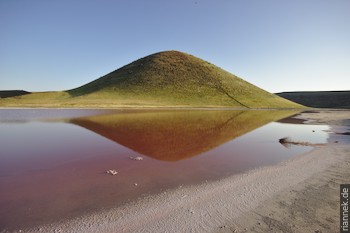
About 100 km east of Konya, there is a series of small but fine volcanoes near Karapinar: several cinder cones, lava fields, tuff rings and maars (cf. The Formation of Mountains). The last eruptions took place between 6000 and 3000 years before today.
The crater lake Meke Gölü is really fantastically beautiful. Inside a tuff ring, a shallow, partially dried-up salt lake surrounds a cinder cone rising in the centre. In an excursion guide I find datings, the maar formed during an eruption 4 million years ago. The rising magma met a lot of groundwater, water vapour explosions occurred, forming an elliptical crater 1800×1600 m in diameter. The magma fragmented into fine material that formed a tuff ring around the crater and wafted into the surrounding area in pressure waves of ash and hot gases (surges). The second eruption with the formation of the cinder cone took place much later, 9000 years ago. This time there was not so much groundwater. Small explosions ejected lava fragments from the vent, which accumulated to form a 300 m high volcanic cone. Besides this, there are three small hills of rhyolitic tuff that lie as islets in the lake.

The highly saline water of the lake has very high contents of K, Na, Ca, SO4 and Cl. Since a lot of water is pumped from wells in the Konya Basin, the groundwater level is sinking and the ratio between infiltrating and evaporating water is changing. In recent years, the water level of the lake dropped sharply and the water became increasingly saline. This led to a white layer of salt precipitating at the bottom of the lake. The water turned red because halobacteria feel particularly at home in increasingly salty water. In 2014, the lake even dried up completely (Hurriyet). During our visit, a large part of the salt surface was covered with water.
Almost all sources on the internet say that Meke Gölü means “stinking lake” and indeed the lake does smell, which is due to numerous solfataras. According to the excursion guide, however, the name is derived from a bird, the coot, which is called “sakarmeke” in Turkish.
To get there from Karapinar, follow the main road towards Eregli for 8 km. Then a small signposted road branches off to Meke Gölü, whose northern crater rim is reached after 2 km. The southern rim is higher and offers better views. Another large cinder cone lies in the neighbourhood.

On the other side of the main road, after another 2 km, lies the circular Maarsee Aci Gölü. This one does not look so fantastic, but it is nevertheless a textbook specimen. In fact, in a scientific book on volcanic lakes, it serves as a prime example of a maar.
Update: My photo of Meke Gölü is the cover of the 5th edition of the geology textbook Grundlagen der Geologie by Bahlburg and Breitkreuz.